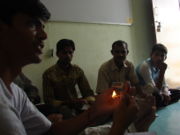Community Media/MARAA/Community Radio/Participation
Participation is a key word and concept in implementing a community radio station. There are various levels at which you can encourage the community to participate.
Contents
Capacity Building
Objective - To arrive at mechanisms (consultatively) which increase community participation in all aspects of programming, listenership and feedback
Note - By the end of this workshop module, you should arrive at specific mechanisms which will help the community radio station in question, to increase community participation both qualitatively and quantitatively.
Duration - The generic module and exercises listed below is for two days. However, these two days will help you get an understanding of the current attitudes of the people at the radio station as well as identify the gaps in the radio station as far as participation in programming is concerned. You can have a third and final day of the workshop where you could propose a customized solution to increase participation.
Participants - The people who should participate in this workshop are the reporters, volunteers, and any other people who are directly involved with production aspects in the radio station, for example, producers, station manager etc.
Racing the Matchstick
- Session Chair: Facilitator
- Duration: 30 minutes
- Purpose: To get participants contextualize and arrive at an understanding of current status from view of participants
Click here for a detailed description
Four Corners
- Session Chair: Participant
- Duration: max 30 minutes
- Purpose: To trigger a discussion specifically on community participation through a debate
Click here for a detailed description
Village Walks
- Session Chair: Participant
- Duration: max 60 minutes
- Purpose: To get participants to rethink notions of community space and interactions with community
Click here for a detailed description
Narrowcasting
- Session Chair: Participant
- Duration: Max 120 minutes
- Purpose: To get participants familiar narrowcasting methods and techniques to increase participation in terms of feedback and choice of content
Click here for a detailed description
Film Screening
- Session Chair: Participant
- Duration: max 45 minutes
- Purpose: Team building activity, bring community together in a public space, build program contacts and familiarity within a given village
Click here for a detailed description
Case Study
Maraa facilitated a workshop with Radio Bundelkhand on increasing community participation on the 11-13th of August 2009. We used the module listed above, and as mentioned at the beginning, used the lessons from the first two days, to propose a customized solution for them on Day 3.
Please click here to read about how we implemented this module with Radio Bundelkhand, a community radio station in Madhya Pradesh, India.
Additional Resources
In addition to these activities listed above, there are several other ways of mapping participation which we have employed in the past and found useful. Feel free to add to this list!
- Take last one week of programming from the radio station. Analyze what percentage of voice is that of full time paid staff and what percentage is that of community
- Take last one week of programming from the radio station, and analyze which villages have been represented in the context of the entire coverage area of the radio station
- Take last one week of programming from the radio station and analyze who are the exact community members who are being represented on the radio in terms of caste, religion, gender, age etc, in the context of the larger community which is being covered by the radio station
- Take last one week of programming from the radio station and analyze what are the issues being covered by the radio station, and then have two or three focus group discussions in the village, and bring out the main concerns from these groups. Check if the programs and the concerns from the discussions do co-relate
- Who decides the topic of programs on a daily basis?
- Do community members come in to do independent shows of their choice?
- At what levels do community get involved? Time of broadcast? Scripting? Deciding choice of topic, format? Or only talking in pre-determined programs?
- Are minority groups like adivasi (tribal), dalit (untouchable), scheduled caste and tribe, people with disability, women, senior citizens, children etc, having a say in the operation, function, language, program etc of the radio?
- In a given week, on an average, how many people visit the studio and for what purpose?
- How many phone calls on an average in the span of a week?
- How many letters received in the span of a month?
- What is the level of interactivity in the programming? i.e. how many phone in shows? Do shows conclude with some feedback etc?

